
The first botanical expedition of the NSF-funded PNG floral biodiversity project took place in the Finesterre Range, Madang Province, from September 23 to October 4, 2010, with 9 days of collecting and surveying activities. The expedition team consisted of seven members: Co-PI Dr Allen Allison (Bishop Museum, expedition leader & herpetological survey), PI Dr Shelley James (Bishop Museum), Dr Barry Conn (National Herbarium of NSW), Mr Michael Lovave (PNG National Herbarium), Mr Kaigube (Dick) Fazang (PNG National Herbarium), Mr Bulisa Iova (PNG National Museum - herpetological survey), and Mr Oliver Tallowin (herpetological survey).
Permission for the botanical and herpetological surveys and collection of research specimens was granted by the Teptep Council and local landowners. Local assistants for the botanical surveys included: John Boriso, James Bota, Kevin Dopeke, Joseph Honenu, Penny Honenu, Ekona Kingneka, Bommy Motra, Kalongo Tawali, Kitara Titamun, and Dope.
All collecting took place along trails in the Teptep area, Madang Province, between 2,175m and 2,820m elevation, ranging from stream beds to ridge-tops. Forested areas immediately near Teptep Village were heavily impacted, with introduced and cultivated native crop species and other cosmopolitan weeds dominating the flora. Forested areas outside this zone consisted of moss-Nothofagus forest, dominated by Pandanus, Caldcluvia and Saurauria tree species. Families most commonly collected included Urticaceae, Moraceae, Orchidaceae, and members of the Pteridophyta (ferns). Almost 300 specimens were collected during the nine collection days. Only fertile material was collected in all cases (flowering and/or fruiting specimens, or fertile fronds in the case of ferns). Only if sufficient material was available for three or more specimens were collections made (the primary set of specimens deposited at LAE, the second at BISH, the third at NSW, subsequent collections to be distributed to collaborating taxonomic experts). For each specimen collected, tissues were preserved in silica gel and are available for molecular research projects. Multiple images of the living material collected during the expedition (more than 2,100 images) were captured.
Collection duties were shared amongst the four botanists present on the expedition, but for efficiency tasks were typically assigned as follows: Dr Conn recorded collections details, including plant habit and characteristics, habitat and locality; PI James captured digital images of the living material, collected tissues for molecular analysis, and provided GPS data; Mr Lovave assisted with collection and pressing of specimens, and Mr Fazang scouted for and collected material. Our local field assistants were vital to the collecting effort, and provided us with local common names and uses for the many plant species. Dr Conn worked with Mr Fazang to score fertile tree species as part of their PNGTrees project.
Specimens have been distributed to LAE, NSW and BISH.
Daily field activities
23 September: Arrival; permission for biological surveys granted
24 September: Lenggowa Track to Sidor; 2,500-2,818 m
25 September: Lenggowa Track to Sidor; 2,200-2,575 m
26 September: Along Jetjet River; 2,170-2,200 m
27 September: Siwasiwa forest, track along Sang River; 2,500-2,650 m
28 September: Siwasiwa forest, track along Sang River; 2,400-2,500 m
29 September: Siwasiwa forest & track along Siwasiwa Creek; 2,450-2,510 m
30 September: Mildanbom Road to Madang, near Jetjet River; 2,250-2,280 m
1 October: Miyamotum & Lingowa Valley, Wil Track; 2,200-2,350 m
2 October: Siwasiwa Forest, Sangoba Track; 2,370-2,690 m
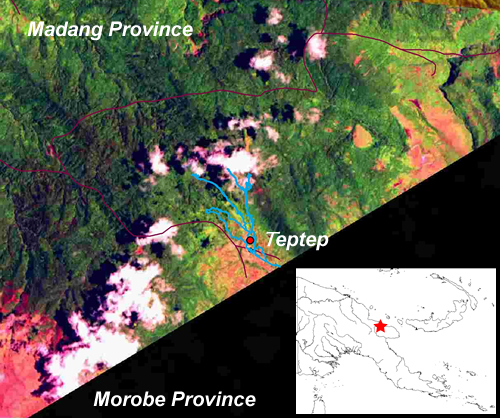
Smugmug.org graciously donated to the Bishop Museum a free professional account in order to archive, and make available via the internet, the almost 800 images of the expedition, people, scenery, and village of Teptep: http://png-bpbm.smugmug.com/Teptep2010. Specimens were exported from PNG to Bishop Museum in August, 2011. The 259 specimens have been accessioned (Accession No. 2011-099) and in the process of being mounted, imaged and incorporated into the Herbarium Pacificum collections. Tissues from SAJ collection numbers are being accessioned into the Pacific Center for Molecular Biodiversity (PCMB 6306-6369), and tissues or aliquots of DNA for Conn numbers are currently held at the Royal Botanic Gardens, Sydney.
The second botanical expedition took place in the Whiteman Range, West New Britain, from May 6-19, 2011. The field work took place in the Mosa-Liem logging area and along Kilis River, mostly in secondarily logged forest, along skid tracks, but also in unlogged forest corridors (Figure 1). During the five field days, 98 specimen collections were made. Specimens were alcohol preserved, dried at the PNG Forest Research Institute & National Herbarium in Lae, and have been preliminarily identified by LAE staff, the PI, and Dr Max van Balgooy. A further 150 live orchid specimens and 20 Hoya species were collected by collaborator Dr. Phil Shearman, and are being cultivated at the University of Papua New Guinea. Collections were also made along the intertidal zone adjacent to the Mahonia Na Dari property, Kimbe Bay. Specimens have been successfully exported from PNG and accessioned into the Herbarium Pacificum (Accession No. 2011-100) and the PNG National Herbarium. Duplicates are being processed and will be distributed to collaborating institutions and specialists in 2012. Tissues for each of the collection numbers have been accessioned into the Pacific Center for Molecular Biodiversity (PCMB 6370-6467) and are available for use by researchers. Images of the expedition can be found at http://png-bpbm.smugmug.com/Fieldwork/West-New-Britain-2011.
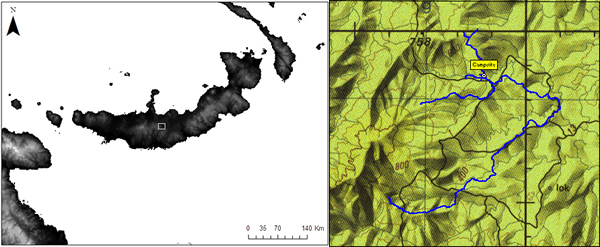
Expedition participants included Shelley James and Allen Allison (Bishop Museum), Bulisa Iova (PNG National Museum), Phil Shearman (UPNG Remote Sensing Center), Dubi Damas (PNG Forest Research Institute), and Clive Sewelu (PNG Forest Authority). Local field assistants included David Bir, Didimas Rouilo, Joshua Viatme, and Penias Molokio. Pre- and post field accommodations while in Kimbe were provided by Mahonia Na Dari, a non-profit non-government organization. They also provided storage facilities for equipment left for the fourth expedition in August, 2011.
The second expedition undertaken during the second year of funding (July 10-17, 2011) was to the Kamiali Wildlife Management Area and Field Station, Morobe Province, primarily with funding from the John D. and Catherine T. MacArthur Foundation. The primary goal of this expedition was to create a trail to Blue Mountain for the installation of Campbell Scientific weather stations at both the summit and Bishop Museum's Cliffside Field Station (Figure 2). Above Cliffside, there is no available water source, and the lack of rainfall during the expedition period limited the potential to travel much beyond Top Camp, established in 1992 by Wayne Takeuchi. Beyond Top Camp, a trail to the summit had to be established. Only a limited amount of time (2 days) was available for the collection of flowering and fruiting specimens, resulting in 30 pressed specimens and 10 living collections being made. The specimens were pressed in the field and dried at the PNG Forest Research Institute & National Herbarium in Lae, and have been preliminarily identified by LAE staff and the PI. The living collections are currently housed at the University of Papua New Guinea, Port Moresby. Images of the expedition can be found at http://png-bpbm.smugmug.com/Fieldwork/Kamiali.
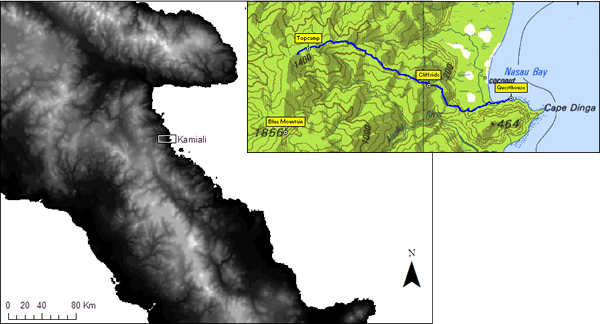
Participants on the expedition included Shelley James and Allen Allison (Bishop Museum), Bulisa Iova (PNG National Museum) and Oliver Paul (PNG Forest Research Institute). Field assistants from Kamiali Village included Sere Ben, Oliver Lebi, Nero Nadap, Enock Nasa, and Marcus Simon. Ten to 15 other villagers assisted with the transportation of equipment to and from the Cliffside Camp.
Living collections of orchids made in the same region in Kamiali by collaborator Dr. Phil Shearman, UPNG Remote Sensing Center, during October, 2010 with Co-PI Allen Allison. Dr Shearman collected 70-90 species of orchid, some of which are new records for the region.
A second expedition to the Whiteman Mountains, West New Britain, to higher elevations, was conducted from August 1-11, 2011 (Figure 3). During the six field collection days, 122 pressed specimens collections were made, and 61 living collections of orchids and 6 collections of vining Apocynaceae were made and deposited at the University of Papua New Guinea for cultivation. None of these specimens have yet flowered, allowing for identification. All specimens were photographed in the field, and tissues for future molecular analysis were taken. It was hoped that helicopter access to 1,600 m would be possible, but cloudy weather conditions did not allow for safe landing at the helicopter pad during the entire expedition timeframe. Specimens were alcohol preserved, dried at the PNG Forest Research Institute & National Herbarium in Lae, and have been preliminarily identified by LAE staff and PI. The specimens will be exported upon the return of the PI to PNG for the expedition proposed for January, 2012. Images of the expedition can be found at http://png-bpbm.smugmug.com/Fieldwork/West-New-Britain-Aug2011.
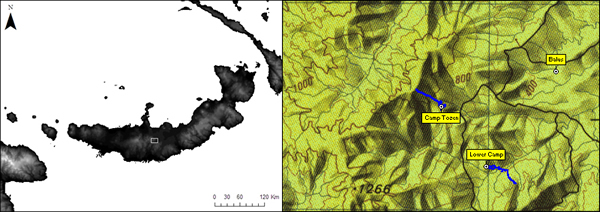
Participants during the expedition were Shelley James and Allen Allison (Bishop Museum), Bulisa Iova (PNG National Museum), Jamie Fuller (Colorado State University), and Oliver Paul (PNG Forest Research Institute). Local field assistants included Balwin Andrew, Solomon Boloma, Otto Francis, Mark Manasa, Noah Michael, Esron Molokio, Penias Molokio, Patrick Nelson, Thomas Riblo, Douglas Romio, and Ben Sevil. Approximately 10 other villagers were hired to transport equipment and supplies to the field camp at Tozen.
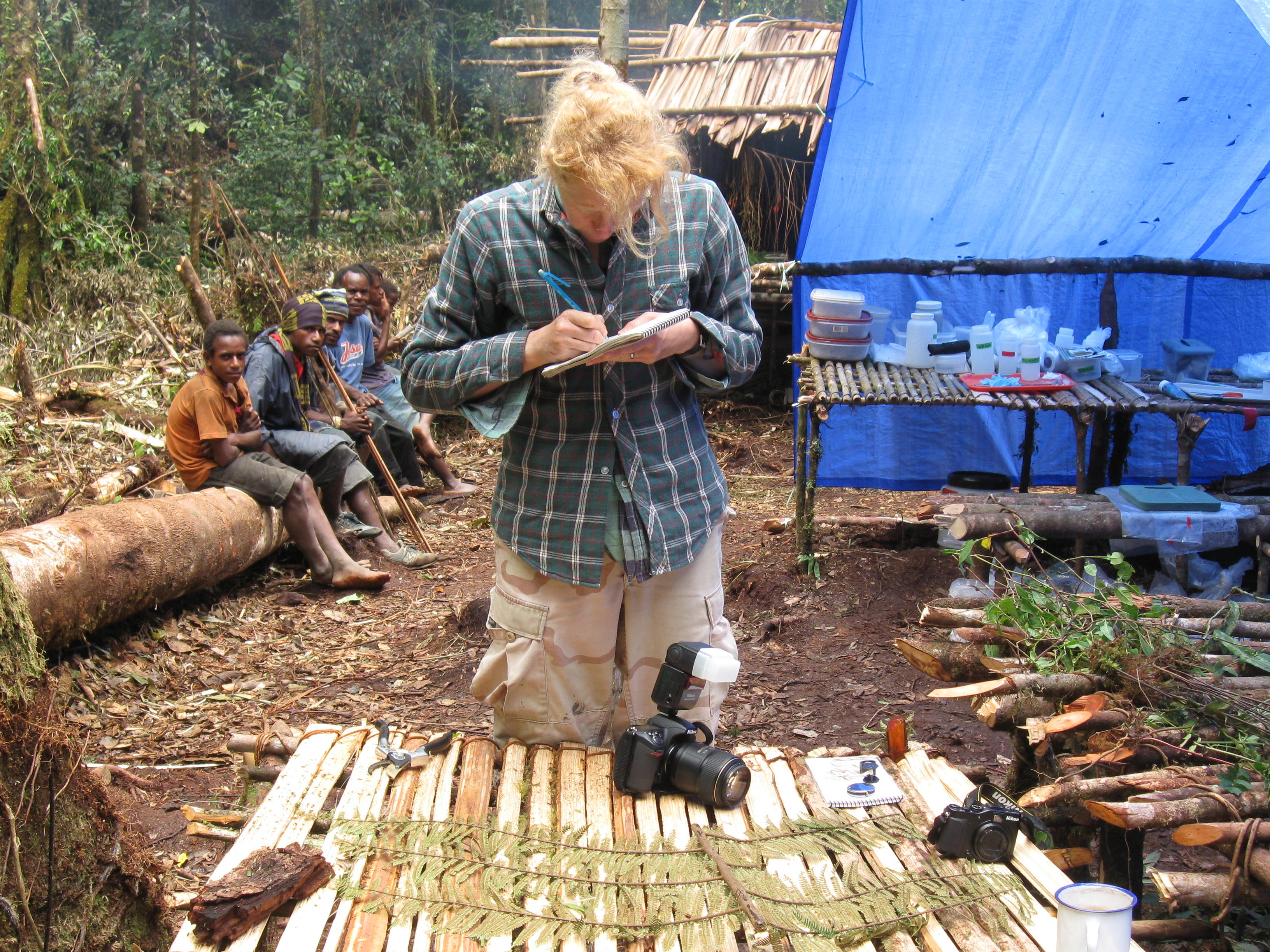
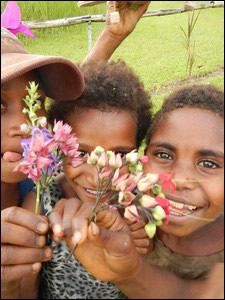 The expedition to Mount Strong took place from February 10 to March 12, 2012. Co-PI Allen Allison made a reconnaissance trip to Gariana and the valley in July, 2010 in order to organize the logistics associated with the expedition and to obtain agreements with the local communities for the biological surveys to be undertaken and permission for collections to be made. Access to Mt Strong is via weekly air service to Garaina Station, then through the Bubuu Valley west of the airstrip by foot. There are a series of villages connected by a track from Garaina Station. Saurere (Saulele) village is located at about 1,500 m elevation and is a little over 7 km from Garaina Station at about 750 m, and takes 4-5 hours. We established camps at 1900 m, 2200 m, and 2900 m. Dr Ed de Vogel from Nationaal Herbarium Nederland joined the expedition team to document the orchid flora of the region, and made collections of more than 600 species of orchids. PhD candidate Stephanie Pimm Lyon from the University of Wisconsin-Madison studying the orchid genus Corybas, and Nathalie Simonsson, studying Hoya and Begonia species, joined the expedition. Dubi Damas, from the Forest Research Institute, Lae, and Bulisa Iova from the PNG National Museum also joined the expedition team.
The expedition to Mount Strong took place from February 10 to March 12, 2012. Co-PI Allen Allison made a reconnaissance trip to Gariana and the valley in July, 2010 in order to organize the logistics associated with the expedition and to obtain agreements with the local communities for the biological surveys to be undertaken and permission for collections to be made. Access to Mt Strong is via weekly air service to Garaina Station, then through the Bubuu Valley west of the airstrip by foot. There are a series of villages connected by a track from Garaina Station. Saurere (Saulele) village is located at about 1,500 m elevation and is a little over 7 km from Garaina Station at about 750 m, and takes 4-5 hours. We established camps at 1900 m, 2200 m, and 2900 m. Dr Ed de Vogel from Nationaal Herbarium Nederland joined the expedition team to document the orchid flora of the region, and made collections of more than 600 species of orchids. PhD candidate Stephanie Pimm Lyon from the University of Wisconsin-Madison studying the orchid genus Corybas, and Nathalie Simonsson, studying Hoya and Begonia species, joined the expedition. Dubi Damas, from the Forest Research Institute, Lae, and Bulisa Iova from the PNG National Museum also joined the expedition team.
During the expedition, 488 botanical collections (SAJ0312-SAJ0799) were made. A duplicate set has been deposited at LAE, and the remaining sets have been successfully exported to BISH and are awaiting freezing, accessioning and further processing, including distribution to other US and international herbaria. Live orchid collections (total 1,778) were successfully exported to Leiden Hortus Botanicus by Dr. de Vogel, with 80% surviving the transplantation as of December 2012. At least 4, possibly as many as 10, new orchid species were collected during this expedition.
PI James and University of Hawaii Masters Student Autumn Amici travelled to Papua New Guinea in June 2012 to undertake research at the Kamiali Wildlife Management Area. However, due to safety issues associated with village conflict, the project plan had to be reconsidered. With the assistance of Bing Siga, agreement was reached with the village community leaders of Siboma, Morobe Province, and fieldwork was undertaken in the area from 8 to 25 June, 2012. Autumn gathered data for her graduate research, assessing the alpha- and beta- diversity of tree species in logged and unlogged forests of the area. She is currently analysing the data, and will be defending her thesis in March 2012. Dr. James with Dubi Damas from the Forest Research Institute (Lae) and local assistants collected 150 specimens (SAJ0800-SAJ0949) from the area. These have been dried and are awaiting exportation from PNG during the next expedition in January 2013.

The first expedition in 2013 was to the Sibium Mountains, Northern Province from 1-25 February, 2013. Participants included Drs Allen Allison and Shelley James (Bishop Museum), Dr Si He, a bryologist from Missouri Botanical Garden, Dr Michael Sundue (University of Vermont), studying the fern family Grammitidaceae, and herpetological student Oliver Tallowin. A flight from Port Moresby to Itokama was chartered, and the field team trekked along the Kapa Kapa Trail and created camps about 10 km south of Itokama, at approx. 710 m (Akupe Camp) and 1,400 m (Idoknama Camp), with collecting up to approx. 2,030 m. Drs Si He and Michael Sundue spent 2 weeks in the Sibium Mountians, then chartered a flight to Goroka, Eastern Highlands Province, to spend three days collecting specimens in the Mt. Gohavisuka Provincial Park. More than 1500 new plant specimens were collected during the three week expedition, including 261 vascular plant specimens, 240 ferns, and 643 moss specimens, all of which have been separated into duplicate sets and distributed to the PNG National Museum, Bishop Museum, the Missouri Botanic Gardens, and the University of Vermont. Tissues of the vascular plants are stored at -20 C at the Bishop Museum, and the tissues from ferns are being stored at the University of Vermont.
Expedition 8, from 12-19 October, 2013, involved the chartering of a helicopter from Helifix, based in Port Moresby. Base camp was the Telikom Repeater Station upon Mount Yule, Central Province. The expedition participants included Drs Allen Allison, Shelley James (Bishop Museum), Phil Shearman (UPNG), and Bulisa Iova (PNG National Museum). During the six days of fieldwork, 102 collections were made, at 3,200-3,270 m elevation. A further 15 live orchid collections were made, and are currently being cultivated under nursery conditions at about 1500 m elevation in Ukarumpa. The specimens and tissues for molecular analysis have been exported to Bishop Museum, and a duplicate set of specimens was left at the PNG National Herbarium.
From October 30 to November 13, 2013, the ninth expedition was held on the flanks of Mount Gerebu, Sogeri Plateau, Central Province. Access to the area was possible by 4WD vehicle. The participants of the expeditions included Drs Allen Allison, Shelley James (Bishop Museum), Dubi Damas (Forest Research Institute), Bulisa Iova (PNG National Museum). During the 15 days of field work, 214 herbarium collections and 25 live collections of Orchidaceae, Hoya and Hydnophytum specimens were made. The live collections are being cultivated at the University of Papua New Guinea, and the herbarium collections have been dried and await export. Dried tissues for molecular study have been exported to the Bishop Museum, and are being stored at -20 C.
PI James travelled to Lae, Morobe Province in September 2014 to work in the PNG National Herbarium. A one-day adventure to the forests of Oomsis was undertaken to search for specimens in the Cannabaceae and Fabaceae families.


